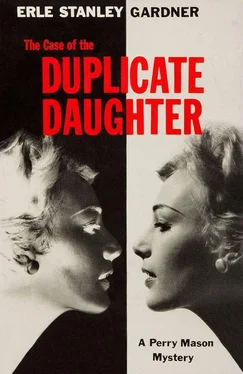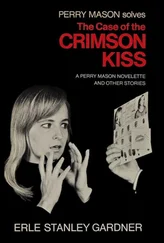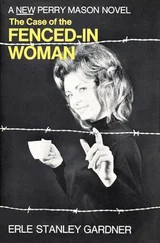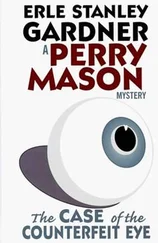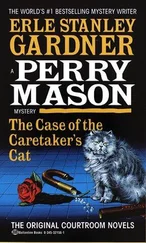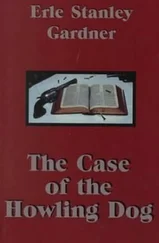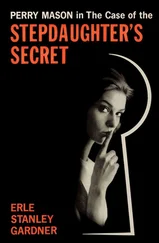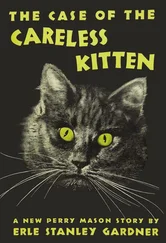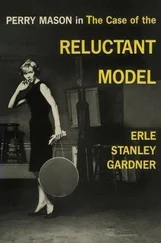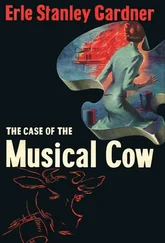“I see,” Mason said. “Now, you had been in Redding before you went to the army and that is the reason you returned there?”
“Yes.”
“What education have you had, Mr. Elliott?”
“I graduated from high school and had three years of college—”
“What high school?”
“Redding High School.”
“While you were living in Redding,” Mason asked, “did you know a family by the name of Monroe?”
There was a long period of silence.
“Can’t you answer that question?” Mason asked.
“Are you referring to G. W. Monroe, the big lumber man?”
“Yes.”
“I knew him, yes. I... yes, I knew him.”
“And,” Mason said, “did you know his daughter, Maureen Monroe?”
“Yes, I knew her.”
Mason said, “Now, Mr. Elliott, you have testified that on the morning of the thirteenth you saw Glamis Barlow running from the workshop. I am going to show you this photograph and ask you if this isn’t the person you saw running from the workshop.”
“Just a moment, just a moment,” Hamilton Burger said. “I want to see that photograph before it is shown to the witness.”
The district attorney came bustling forward.
“Take a look,” Mason said, handing him the photograph.
Hamilton Burger looked at the photograph, then smiled. “No objection, Your Honor. No objection whatever.”
Mason pushed the photograph in front of the witness. “Just answer the question,” he said. “Isn’t this a photograph of the person you saw running from the workshop? Didn’t you see Maureen Monroe rather than Glamis Barlow?”
Had Mason hit the witness in the face with the photograph he could not have caused more consternation.
Hamilton Burger, watching the sagging jaw of the witness, jumped up, protesting and waving his hand as though to attract attention, but actually trying to reassure the witness. “Your Honor, Your Honor,” he said, “the question is improper. The photograph is quite plainly that of Glamis Barlow and—”
“I suggest the district attorney be sworn,” Mason said, “or perhaps he should look more closely. The caption which has been folded under the photograph states very plainly that it is a picture of Maureen Monroe, daughter of G. W. Monroe, whose engagement has just been announced to a wealthy young businessman of Arizona and New York.”
Judge Alvord said, “Let me see that photograph, please.”
Hamilton Burger came pushing toward the bench. “I think, Your Honor, there has been some trickery here, that this is another of Mr. Mason’s attempts—”
“Let me see the photograph,” Judge Alvord interrupted.
Mason handed up the photograph.
Judge Alvord studied the photograph, then turned down the sheet of flimsy which had been pasted on the photograph and folded under. He read the typewritten caption, then, without a word, handed the photograph back to Perry Mason and turned to the witness.
“Answer the question,” Mason said, “and remember you’re under oath. Was it Glamis Barlow or was it Maureen Monroe who ran out of that room?”
“Objection, Your Honor!” Hamilton Burger shouted. “We don’t know that this photograph is properly authenticated. I object to the question on the ground that it is argumentative, that it calls for a conclusion of the witness, that it is not proper cross-examination, that no foundation has been laid.”
“Overruled,” Judge Alvord snapped. “The witness will answer the question.”
“I... I... I don’t know. Looking down from the window... now that I think of it... there is a very remarkable resemblance.”
“I see,” Mason said. “So now you are not prepared to swear that it was Glamis Barlow you saw running out of that workshop?”
“No, sir.”
“You wish to change your testimony to state that you are not sure that it was Glamis Barlow you saw?”
“Yes, sir.”
“Now, then,” Mason said, “how long have you known Vera M. Martel?”
The witness began to fidget in the chair.
“You’re under oath,” Mason said. “How long have you known her?”
“Objected to as not proper cross-examination,” Hamilton Burger said.
“Overruled,” Judge Alvord snapped.
“I... I first met her about a month ago.”
“Where?”
“In Las Vegas, Nevada.”
“And how did you meet her?”
“I was introduced to her by a friend who told me that she was a very resourceful, daring private investigator.”
“Now then,” Mason said, leveling his finger at the witness, “did you or did you not enter into any business transaction with Vera Martel?”
The witness suddenly straightened. “I refuse to answer,” he said.
Judge Alvord leaned forward ominously. “Upon what ground?”
The witness looked up defiantly. “Upon the ground,” he said, “that the answer would tend to incriminate me.”
Mason calmly walked back to the defense counsel table and sat down. “No further questions, Your Honor.”
Hamilton Burger was on his feet. “Your Honor, this... this comes as a most complete surprise. A situation has developed here which certainly should be investigated. I want to find out more about that picture. I want to authenticate that picture. I feel that counsel has been guilty of a substitution here, that this picture of Glamis Barlow, has received a wrong caption and has been used deliberately to confuse this witness. I would like to ask for a continuance until I can verify this picture and ascertain what has happened.”
“I have no objection to a continuance,” Mason said. “The defense would like very much to have the district attorney verify the photograph, and I feel that the district attorney should pursue further the question of why this witness refuses to answer questions about his business deal with Vera Martel.”
Judge Alvord said, “Mr. Mason, I am going to ask you if, to your knowledge, there has been any substitution of photographs or captions in this case.”
“No, Your Honor. I have just received this photograph from a detective who arrived in this court just a few minutes ago in response to a telephone conversation with him I had last night in which I asked him to bring down photographs of Maureen Monroe.”
In the silence that followed there was the sound of a woman sobbing.
Judge Alvord looked down at Nancy Gilman, who was crying.
“The Court is going to take a recess until tomorrow morning at ten o’clock,” he said. And then, turning to Hamilton Burger, said, “I would suggest that, in the meantime, the police make every effort to get at the bottom of this. There is certainly a situation here which should be thoroughly investigated.”
“Very well, Your Honor,” a chastened Hamilton Burger said.
“Court’s adjourned,” Judge Alvord announced, and then gave Mason a long look of puzzled respect before arising and leaving the bench.
It was late that afternoon when Paul Drake entered Mason’s office.
“Well,” he said, “Hartley Elliott confessed. Of course, it all became apparent after Nancy Gilman made her statement.
“Nancy gave birth to twin girls. They were identical twins. She felt she couldn’t keep them both, but she wanted one. Nancy was a remarkably intelligent, resourceful woman. She wanted to get a good home for the other daughter. She learned in some way that Mrs. G. W. Monroe of Redding had been confined and had given birth to a Mongoloid. The woman was heartbroken, so Nancy arranged a substitution and the Monroes returned to Redding with a beautiful daughter.
“The girls are absolutely identical. Even now it is almost impossible to tell them apart. When Hartley Elliott met Glamis he was so struck by the amazing resemblance that he started a quiet investigation. He wanted to find out about it, so he employed Vera Martel.
Читать дальше
